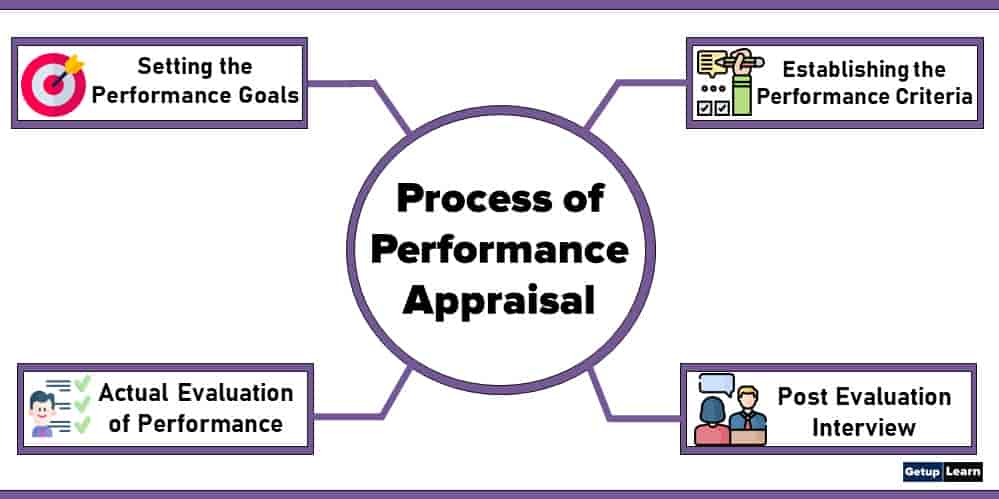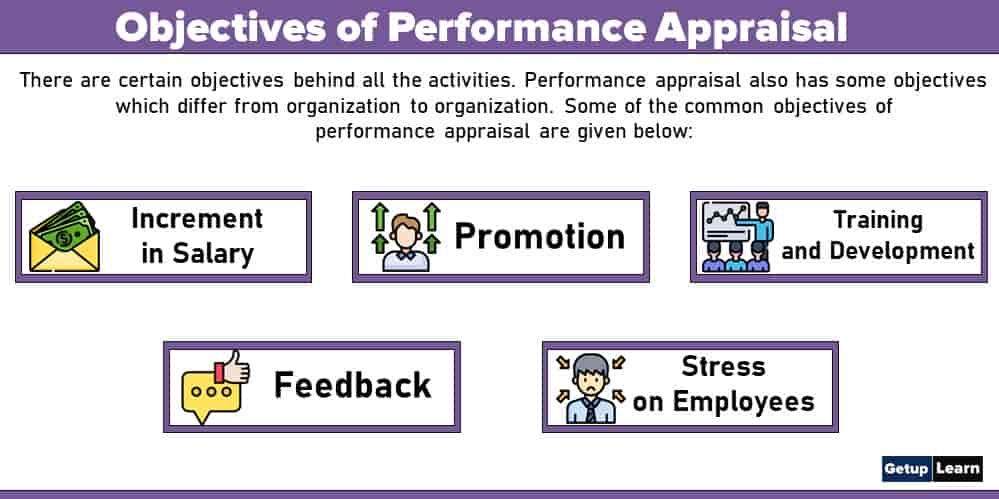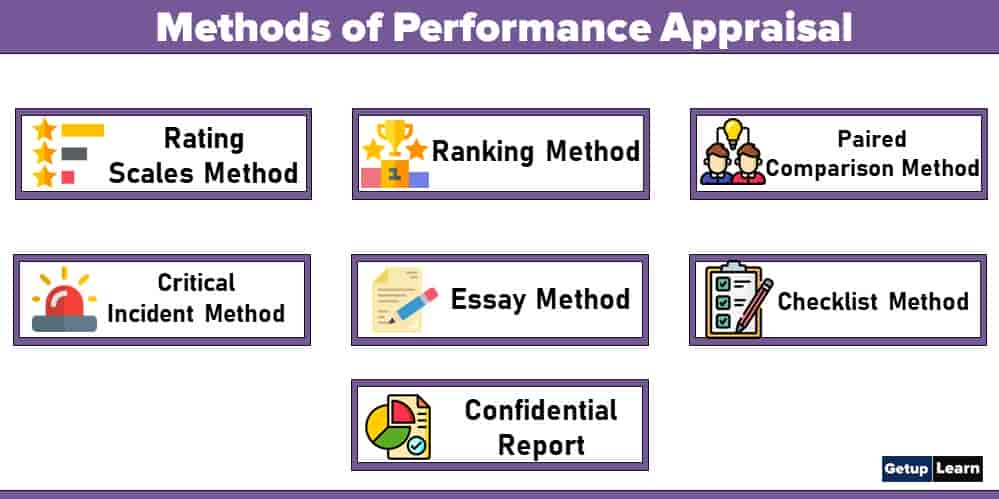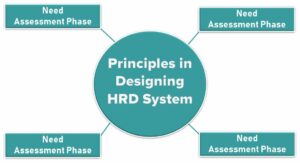Table of Contents
What is Process of Performance Appraisal?
The process of performance appraisal should start at the top and be built into the strategy of the firm. It should strengthen the working relationship between the managers and their employees. It should also contribute to the long-term success of the organisation. The process of performance appraisal should be a rewarding and satisfying experience not only for the organisation but also for the individual employee.

The purpose of conducting the performance appraisal must be decided in advance. The appraisal is concerned with the following:
- Promoting understanding between the supervisor and his subordinate.
- Highlighting employee needs and opportunities for personal growth and development.
- Creating a satisfactory level of performance for employees in their present job.
- Providing useful criteria for determining the validity of selection and training methods and techniques and forming concrete measures for attracting individuals of a higher calibre to the enterprise.
- Aiding in decision-making for promotions, transfers, lay-offs, and discharges.
To what range of employees it should be extended must be specified. All employees of an organization should be appraised by the operator to the top-level management need to be appraised for one reason or the other.
To decide who will evaluate employees. Determining who will evaluate employees is critical in designing the appraisal program. It is generally conceded that appraisal by the immediate supervisor is necessary and the most effective method. However, other persons are sometimes involved in the appraisa1 process and in various combinations.
Objectives of Performance Appraisal
There are certain objectives behind all the activities. Performance appraisal also has some objectives which differ from organization to organization. Some of the common objectives of performance appraisal are given below:

Increment in Salary
Performance appraisal helps the management to decide about the employees who deserve to get an increment in their salary. The salary increment of an employee depends on their overall performance. A formal performance appraisal process is mostly required in large organizations, where the employees are large in number and have different kinds of work.
Therefore, it becomes quite important to keep track of the performance of each employee on regular basis.
Promotion
Promotion means an up gradation in the designation of the employee in an organisation. Promotion helps in increasing the motivation level of the employees. So in the light of performance appraisal and merit rating, organizations can easily decide on the strong and weak points of their employees.
And thus, it can be simply determined which employee should be promoted to a higher level and which employee should be demoted to a lower level for its poor performance.
Training and Development
Another objective of performance appraisal is to determine the number of employees who needs to be trained in respect of their poor performance. Performance appraisal identifies the strengths and weaknesses of an employee in his present job. Through this organizations get proper information about their employees and design an appropriate training program for them. Performance appraisal helps in identifying the actual training needs in an organization.
Feedback
Performance appraisal helps in disclosing the actual feedback report about the employees. This report tells the employees where they stand. A person works better when he knows how he is working and how his efforts are contributing toward the achievement of the organizational goal.
Hence, performance appraisal also provides satisfaction to an employee that his work is meaningful and worthy for the organization.
Stress on Employees
The last objective of performance appraisal is to put a kind of stress on the employee for better performance. If the employees are conscious that they are being appraised for their work, they will have a tendency to show positive and acceptable behaviour in the organization and would strive to perform better.
Process of Performance Appraisal
The following is the general process of performance appraisal explained below:
- Setting the Performance Evaluation Goals
- Establishing the Performance Criteria
- Actual Evaluation of Performance
- Post Evaluation Interview
Setting the Performance Evaluation Goals
The first step in the process of performance evaluation is setting specific goals. These goals are usually set jointly by both the supervisors and the employees. The goal-setting process ensures that every employee knows what is expected from them and how the achievement of the goal contributes to the overall success. Organisations should select only those goals that are most important and realistically achievable.
Establishing the Performance Criteria
Once the performance evaluation goals have been set up, the next step is to establish performance evaluation criteria. They are reference points on the basis of which other things are evaluated. For evaluation, the characteristics of evaluation have to be decided.
These criteria should be job related, specific and within the control of the employees. For deciding the criteria, there should be a joint discussion between superiors and the employees. Once the criteria are decided, they should be communicated to all those who are concerned.
Actual Evaluation of Performance
Once the criteria for evaluation are communicated, the performance of the employee is evaluated on that basis. The performance of the employee is evaluated by comparing the job performance of the employee with the established standard.
By doing so, it helps the organisation to determine if the employees are able to meet the standards, ascertain reasons for deficiency and prepare plans to correct the problems.
Post Evaluation Interview
Once the evaluation is over, the superior can have a meeting with the employee to discuss the results of the performance appraisal which has been undertaken. The evaluator and the supervisor help the employee to understand their strengths and weakness and how these weaknesses can be reduced. During this meeting, the goals for the next period are also setup.
Methods of Performance Appraisal
Before deciding on the methods of performance appraisal, it is important to decide which aspects are to be evaluated and how they should be evaluated. The method of performance evaluation should be chosen very carefully. The following are the performance appraisal tools which can be used by the organisation:
- Rating Scales Method
- Ranking Method
- Paired Comparison Method
- Critical Incident Method
- Essay Method
- Checklist Method
- Confidential Report (CR)

Rating Scales Method
Under this method, the employees are rated on prespecified factors. This method is simple and easy to adopt as it helps in prompt evaluation of several employees at a time. The performance of the employees is recorded on a scale. This scale includes traits such as reliability, interpersonal skills and adaptability as well as a range of performance expected for each trait.
Scales may have various scores which represent outstanding, average, improvement required etc. The evaluation is done by circling the scale for each factor which describes the performance of the employee. Finally, the assigned values are summed up for each trait. This method avoids subjectivity and is so ideal for evaluating the performance of the employee. But it might be possible that the evaluator may be biased.
Ranking Method
It is also one of the oldest and easiest methods of evaluation. Each employee is ranked by the evaluator on the basis of their relative worth to the organisation. Each employee is evaluated and the employee secures a place in the ranking order ranging from the top most to the bottom-most for selected characteristics.
The best employee on the list is ranked the highest and the poorest one is at the bottom for the same trait. It is generally used as it enjoys ease of administration but it suffers from several defects. This method may have evaluators’ bias and prejudice as they may be influenced by the overall personality of the employee who has been evaluated.
Paired Comparison Method
It is a variant of the ranking method. Here two employees are considered as a unit. One employee is compared with another. In the same manner, pairs of employees are formed and each employee is compared with another till all employees are compared with each other.
The employee with the greatest number of favourable responses in the inter-person comparison gets the highest ranking. The major defect of this method is that it may not be appropriate when many employees have to be compared in a short span of time.
Critical Incident Method
Under this method, the supervisor maintains a written record of positive and negative work-related actions of employees. During the evaluation, these records can be used as supporting data for evaluating the performance of the employee. The major advantage of this method is that the employee is able to identify areas in which they are strong or weak and it also points out how the deficiencies in the performance of the employees could be reduced.
It also ensures that the performance of the employees is continuously evaluated and due to it, it facilitates better counselling of the employees by the supervisor. On the other hand, this method may be difficult to follow as it may be difficult to record all incidents on a regular basis.
Essay Method
In this method, a short description of an employee’s performance is written which provides a narrative of the employee’s strengths, weaknesses and potential. The focus is more on extreme behaviours are work. But the efficiency of this method is on the extreme behaviour of the employees.
The success of this method depends on the evaluator’s writing skills and objectivity. The implementation of this method does not require any complex preparation or training. But there is scope for manipulation by evaluators if he has excellent writing skills where he can project a mediocre worker as an excellent performer.
Checklist Method
In this method, a checklist containing a series of statements on traits of employees is prepared and presented to the evaluator who is generally the supervisor of the employee. It contains both positive and negative statements. Each statement has to be answered in ‘Yes’ or ‘No’ format.
Once the evaluation is completed by the evaluator, the checklist is sent to the Human Resources department for further processing such as assigning predetermined scores and totalling such scores. This method is simple, objective, time-saving and cost-effective.
It also does not require any specialised training on the part of the evaluator. But there is scope for the evaluator’s bias as ambiguous statements can cause confusion and misinterpretation. Moreover, the focus is generally on the personality factors rather than on performance factors.
Confidential Report (CR)
A confidential report is used in government and public sector organisations. The evaluation records are kept confidential and are accessible only to pertinent officials. The report is prepared by immediate supervisors on the basis of continuous observation of employees for a period of time.
A predetermined format for gathering data relating to employee’s skills, ability, knowledge, initiative leadership, skills, attitude, integrity, the scope for improvement, aptitude for learning, area of concern and weakness. This method enables continuous evaluation of employees and the supervisors have better control over them, but the report may be subject to the evaluator’s bias and prejudice.
Problems in Performance Appraisal
Performance evaluation is a very important exercise for the organisation as well as employees. It helps the employees to understand their future prospects as well as rewards. The success of the performance appraisal methods depends on the quality, credibility and unfailing nature process. But there are many problems in performance appraisal in the organisation which are discussed:
- Absence of Objectivity
- Halo or Horn Effect
- Rating all as Average
- Overly Critical Attitude of the Evaluator
- Bias
- Evaluation at a Predetermined Time
- Employee Resistance

Absence of Objectivity
Performance appraisal methods should be objective and free from any personal bias. But many times, the performance appraisal techniques may be full of bias and it may undermine the fairness of the evaluation method.
Halo or Horn Effect
It may be possible that the image of any employee’s positive trait may affect the overall evaluation of the employee’s performance. Such an influence of the positive trait on the performance appraisal report is referred to as the ‘Halo effect’.
On the contrary, it may also be possible that a negative impression in the mind of the evaluator may also influence the overall performance appraisal report. Such an influence of a negative trait on the performance appraisal report is referred to as the ‘Horn effect’.
Rating all as Average
It might be possible that the evaluator may rate all employees are average without any justification. Generally, this undermines the usefulness of the evaluation process for deciding promotions, rewards and training and development activities.
Overly Critical Attitude of the Evaluator
It might also be possible that the evaluator may give higher ratings to all employees without any justification just to stay clear of any controversy over the evaluation. On the other hand, it might be possible that the evaluator may be excessively critical of an employee’s performance which would affect the fairness of the entire evaluation procedure.
Bias
It might also be possible that individual differences such as gender, race, age or any such characteristic may impact the rating given by the evaluator. Such behaviour has an adverse influence on the outcome of the evaluation and affects the objectivity of performance appraisal.
Evaluation at a Predetermined Time
When the evaluation process is undertaken at a predetermined interval then it might be possible that the employees tend to present their best behaviour and improve their productivity just ahead of the scheduled time. Due to this, the performance appraisal process may be biased.
Employee Resistance
It might be possible that the employees consider performance appraisal as an opportunity for the supervisor to highlight their negative aspects. This feeling among the employees may lead the employees to resist the whole activity of performance appraisal.
How do you overcome problems with performance appraisal?
Defective evaluation can harm an organisation as an unfair appraisal of employees may result in strain in superior employee relations and high labour turnover. The following are the steps which can be taken to overcome problems in appraisal process:
- Proper training of the evaluators can help them to observe employee behaviour in an accurate manner. This would help them to overcome problems of lenient attitudes, averaging and the halo effect.
- During the evaluation, the whole evaluation period should be covered and not just events that occur before the evaluation. For this, a diary should be maintained by the supervisor to record both positive and negative critical incidents.
- The purpose of evaluation and merits of each tool should be evaluated and studied in detail for choosing the right tool for evaluation.
- Sample jobs should be given to the evaluator so that they are able to evaluate the performances in an effective manner.
What is the process of performance appraisal process?
The following are steps included in process of performance appraisal in hrm:
1. Setting the Performance Evaluation Goals
2. Establishing the Performance Criteria
3. Actual Evaluation of Performance
4. Post Evaluation Interview etc.
What is objectivity in performance appraisal?
These are the objectivity in performance appraisal:
1. Increment in Salary
2. Promotion
3. Training and Development
4. Feedback
5. Stress on Employees etc.
How many methods of performance appraisal are there?
There are 7 methods of performance appraisal given below:
1. Rating Scales Method
2. Ranking Method
3. Paired Comparison Method
4. Critical Incident Method
5. Essay Method
6. Checklist Method
7. Confidential Report (CR) etc.
What are the most common errors in performance appraisal?
There are many problems in performance appraisal in the organisation which are discussed under:
1. Absence of Objectivity
2. Halo or Horn Effect
3. Rating all as Average
4. Overly Critical Attitude of the Evaluator
5. Bias
6. Evaluation at a Predetermined Time
7. Employee Resistance etc.













